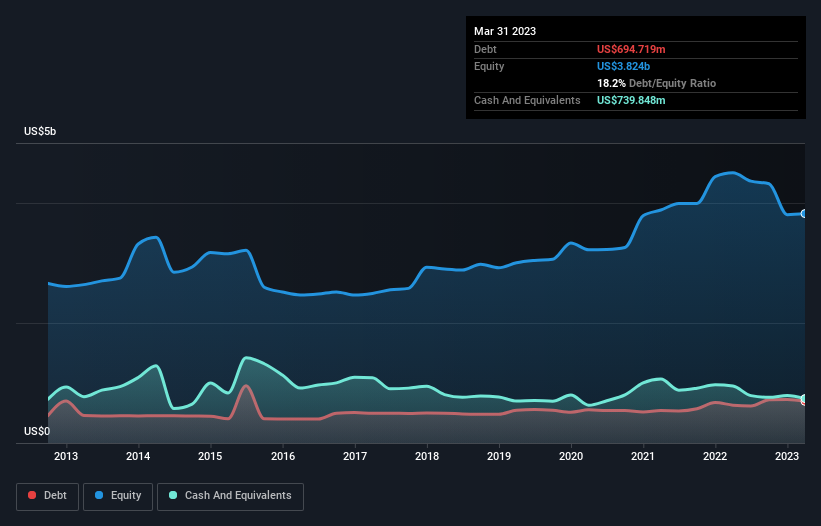- United States
- /
- Consumer Services
- /
- NYSE:GHC
Here's Why Graham Holdings (NYSE:GHC) Can Manage Its Debt Responsibly
The external fund manager backed by Berkshire Hathaway's Charlie Munger, Li Lu, makes no bones about it when he says 'The biggest investment risk is not the volatility of prices, but whether you will suffer a permanent loss of capital.' So it might be obvious that you need to consider debt, when you think about how risky any given stock is, because too much debt can sink a company. We can see that Graham Holdings Company (NYSE:GHC) does use debt in its business. But the real question is whether this debt is making the company risky.
Why Does Debt Bring Risk?
Generally speaking, debt only becomes a real problem when a company can't easily pay it off, either by raising capital or with its own cash flow. If things get really bad, the lenders can take control of the business. While that is not too common, we often do see indebted companies permanently diluting shareholders because lenders force them to raise capital at a distressed price. Of course, plenty of companies use debt to fund growth, without any negative consequences. When we think about a company's use of debt, we first look at cash and debt together.
Check out our latest analysis for Graham Holdings
What Is Graham Holdings's Debt?
You can click the graphic below for the historical numbers, but it shows that as of March 2023 Graham Holdings had US$694.7m of debt, an increase on US$631.1m, over one year. But it also has US$739.8m in cash to offset that, meaning it has US$45.1m net cash.

How Strong Is Graham Holdings' Balance Sheet?
According to the last reported balance sheet, Graham Holdings had liabilities of US$1.13b due within 12 months, and liabilities of US$1.59b due beyond 12 months. Offsetting this, it had US$739.8m in cash and US$510.8m in receivables that were due within 12 months. So it has liabilities totalling US$1.47b more than its cash and near-term receivables, combined.
Graham Holdings has a market capitalization of US$2.64b, so it could very likely raise cash to ameliorate its balance sheet, if the need arose. But we definitely want to keep our eyes open to indications that its debt is bringing too much risk. While it does have liabilities worth noting, Graham Holdings also has more cash than debt, so we're pretty confident it can manage its debt safely.
In addition to that, we're happy to report that Graham Holdings has boosted its EBIT by 56%, thus reducing the spectre of future debt repayments. There's no doubt that we learn most about debt from the balance sheet. But it is future earnings, more than anything, that will determine Graham Holdings's ability to maintain a healthy balance sheet going forward. So if you're focused on the future you can check out this free report showing analyst profit forecasts.
Finally, a company can only pay off debt with cold hard cash, not accounting profits. While Graham Holdings has net cash on its balance sheet, it's still worth taking a look at its ability to convert earnings before interest and tax (EBIT) to free cash flow, to help us understand how quickly it is building (or eroding) that cash balance. In the last three years, Graham Holdings's free cash flow amounted to 41% of its EBIT, less than we'd expect. That weak cash conversion makes it more difficult to handle indebtedness.
Summing Up
Although Graham Holdings's balance sheet isn't particularly strong, due to the total liabilities, it is clearly positive to see that it has net cash of US$45.1m. And it impressed us with its EBIT growth of 56% over the last year. So we are not troubled with Graham Holdings's debt use. The balance sheet is clearly the area to focus on when you are analysing debt. However, not all investment risk resides within the balance sheet - far from it. Be aware that Graham Holdings is showing 3 warning signs in our investment analysis , and 1 of those doesn't sit too well with us...
If, after all that, you're more interested in a fast growing company with a rock-solid balance sheet, then check out our list of net cash growth stocks without delay.
New: Manage All Your Stock Portfolios in One Place
We've created the ultimate portfolio companion for stock investors, and it's free.
• Connect an unlimited number of Portfolios and see your total in one currency
• Be alerted to new Warning Signs or Risks via email or mobile
• Track the Fair Value of your stocks
Have feedback on this article? Concerned about the content? Get in touch with us directly. Alternatively, email editorial-team (at) simplywallst.com.
This article by Simply Wall St is general in nature. We provide commentary based on historical data and analyst forecasts only using an unbiased methodology and our articles are not intended to be financial advice. It does not constitute a recommendation to buy or sell any stock, and does not take account of your objectives, or your financial situation. We aim to bring you long-term focused analysis driven by fundamental data. Note that our analysis may not factor in the latest price-sensitive company announcements or qualitative material. Simply Wall St has no position in any stocks mentioned.
About NYSE:GHC
Graham Holdings
Through its subsidiaries, operates as a diversified holding company in the United States and internationally.
Solid track record with excellent balance sheet.
Market Insights
Community Narratives




